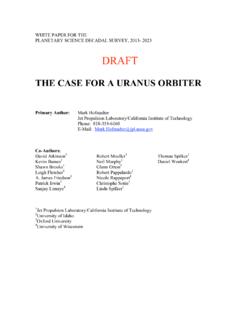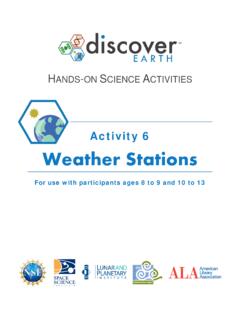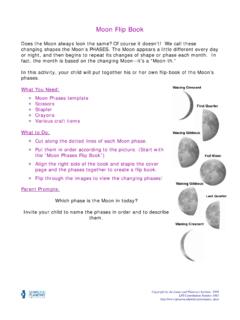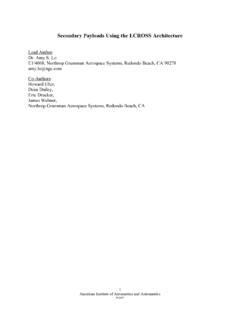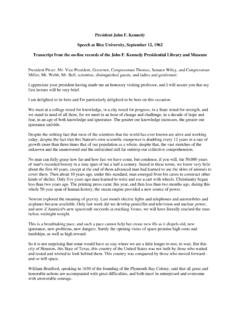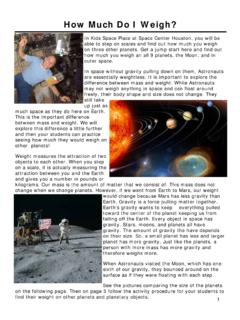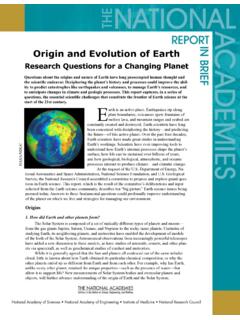Transcription of What Makes a World Habitable?
1 What Makes a World Habitable? Use this table to identify the factors (and the appropriate levels) that will enable you to design your habitable worlds. Factors that make a planet Habitable Not Enough of the Factor Just Right Too Much of the Factor Situation in the Solar System Temperature Influences how quickly atoms & molecules move Low temperatures cause chemicals to react slowly, which interferes with the reactions necessary for life. Also low temperatures freeze water, making liquid water unavailable. Life seems limited to a temperature range of minus 15oC to 115oC. In this range, liquid water can still exist under certain conditions.
2 At about 125oC, protein and carbohydrate molecules and genetic material ( , DNA and RNA) start to break apart. Also, high temperatures quickly evaporate water. Surface: Only earth s surface is in this temperature range. Sub-surface: The interior of the solid planets & moons may be in this temperature range. Water Dissolves & transports chemicals within and to and from a cell The chemicals a cell needs for energy & growth are not dissolved or transported to the cell Water is regularly available. Life can go dormant between wet periods, but, eventually, water needs to be available. Too much water is not a problem, as long as it is not so toxic that it interferes with the chemistry of life Surface: Only earth s surface has water, though Mars once had surface water and still has water ice in its polar ice caps.
3 Saturn s moon, Titan, seems to be covered with liquid methane. Sub-surface: Mars & some moons have deposits of underground ice, which might melt to produce water. Europa, has a vast oceans beneath its outer shell if ice. Atmosphere Traps heat, shields the surface from harmful radiation, and provides chemicals needed for life, such as nitrogen and carbon dioxide. Small planets and moons have insufficient gravity to hold an atmosphere. The gas molecules escape to space, leaving the planet or moon without an insulating blanket or a protective shield. earth & Venus are the right size to hold a sufficient-sized atmosphere.
4 earth s atmosphere is about 100 miles thick. It keeps the surface warm & protects it from radiation & small- to medium-sized meteorites. Venus s atmosphere is 100 times thicker than earth s. It is made almost entirely of greenhouse gasses, making the surface too hot for life. The four giant planets are completely made of gas. Of the solid planets & moons, only earth , Venus, & Titan have significant atmospheres. Mars atmosphere is about 1/100th that of earth s, too small for significant insulation or shielding. Energy Organisms use light or chemical energy to run their life processes. When there is too little sunlight or too few of the chemicals that provide energy to cells, such as iron or sulfur, organisms die.
5 With a steady input of either light or chemical energy, cells can run the chemical reactions necessary for life. Light energy is a problem if it Makes a planet too hot or if there are too many harmful rays, such as ultraviolet. Too many energy-rich chemicals is not a problem Surface: The inner planets get too much sunlight for life. The outer planets get too little. Sub-surface: Most solid planets & moons have energy-rich chemicals. Nutrients Used to build and maintain an organism s body. Without chemicals to make proteins & carbohydrates, organisms cannot grow. Planets without systems to deliver nutrients to its organisms ( , a water cycle or volcanic activity) cannot support life.
6 Also, when nutrients are spread so thin that they are hard to obtain, such as on a gas planet , life cannot solid planets & moons have the same general chemical makeup, so nutrients are present. Those with a water cycle or volcanic activity can transport and replenish the chemicals required by living organisms. Too many nutrients are not a problem. However, too active a circulation system, such as the constant volcanism on Jupiter s moon, Io, or the churning atmospheres of the gas planets, interferes with an organism s ability to get enough nutrients. Surface: earth has a water cycle, an atmosphere, and volcanoes to circulate nutrients.
7 Venus, Titan, Io, and Mars have nutrients and ways to circulate them to organisms. Sub-surface: Any planet or moon with sub-surface water or molten rock can circulate and replenish nutrients for organisms.

